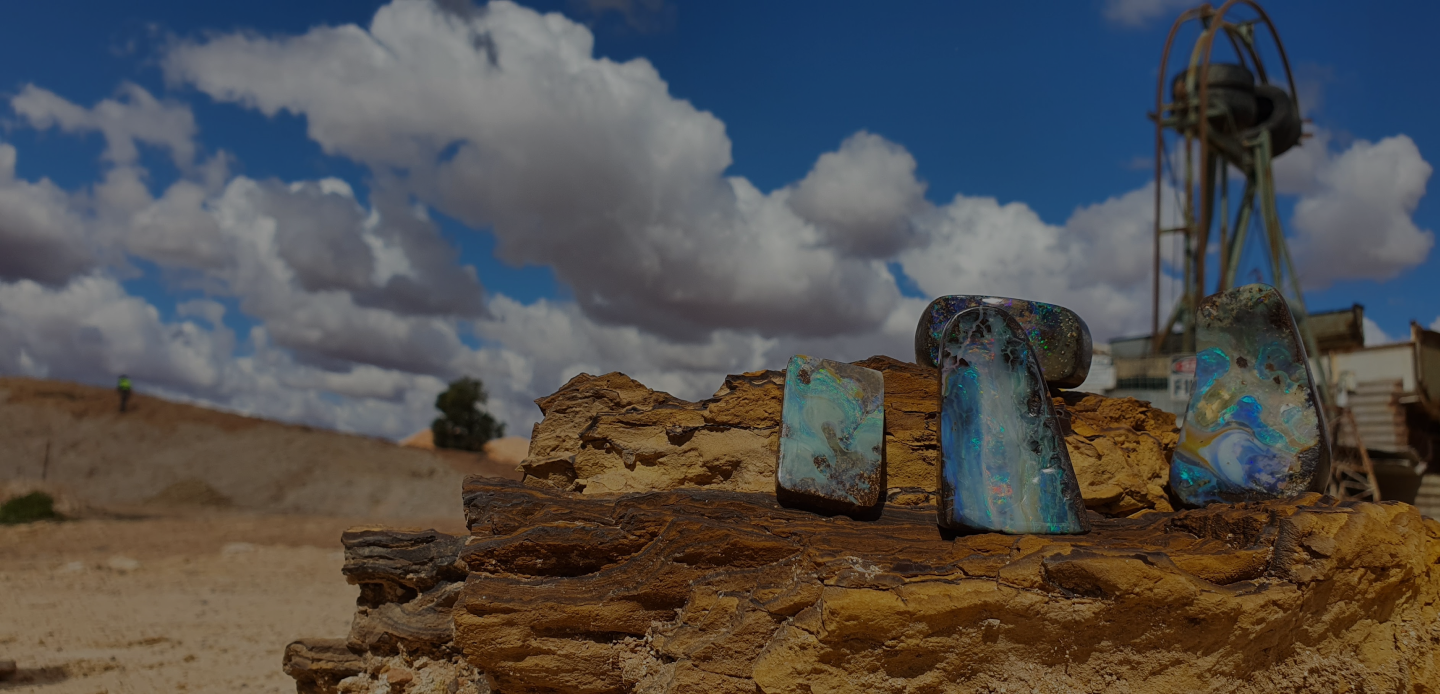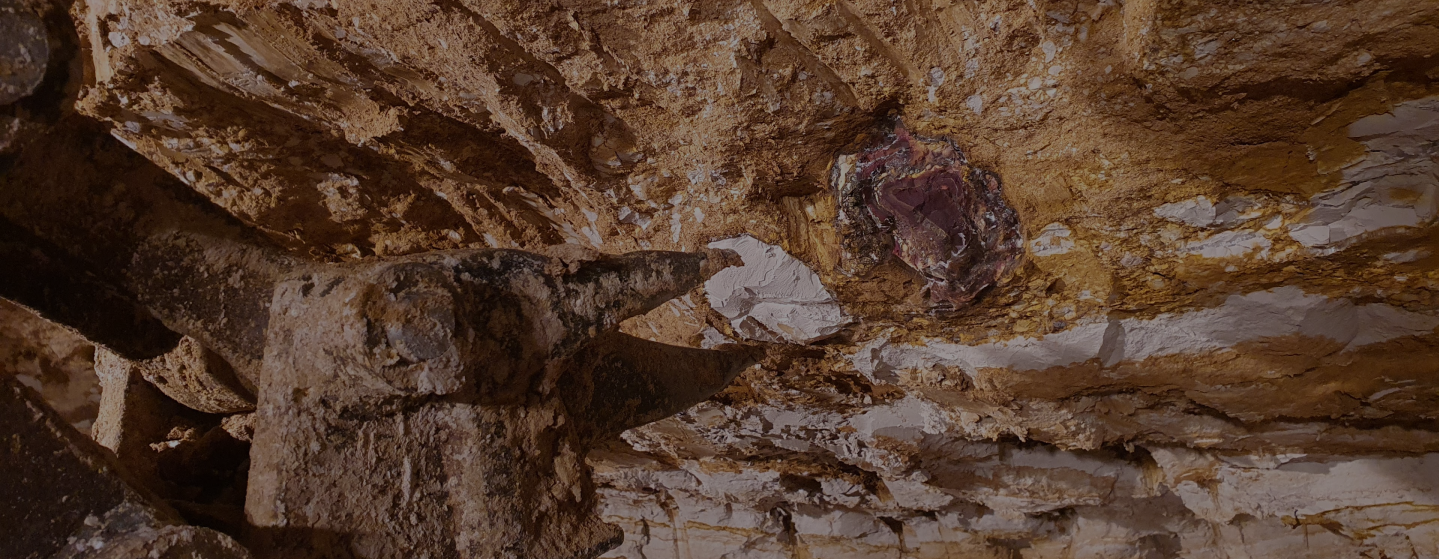
Opal Story
Opal Formation
Located in Windsor, an historic suburb containing a variety of heritage listed sites, including the former Windsor Shire Council chambers and the incredible rock wall at the former Quarry Park.
- The sea created silica rich areas -Silica is basically sand. And silica is the main building block for opal.
- There were periods in the earths evolution when deep acidic weathering occurred releasing tiny silica particles into the ground.
- Then over time water seeped through the ground via springs, the water table raising up and down and possibly large flooding events. This water would carry the silica particles into the empty voids and eventually this silica solution would turn into precious opal.
Most opal has no colour except for black, gray, white or transparent. However if we are lucky and the silica solution is rich enough it starts to grow and form tiny silica spheres. They grow in a similar way to how a car battery works; the negative particles search for the positive particles. It has been proven that a raised tempature also helps in the formation of the spheres. If these spheres grow into the same size, and if they settled down on top of one-another then arrangement this would change the wavelength of light. The small spheres would create a blue play of colour and as the spheres got larger we would go through all colours of the rainbow until we reached red. Red being the rarest (and most valuable) of colours.
A couple of stories from a bygone era (quoted from Len Crams book)
1) “At the Quilpie field at a mine called the Red Show they discovered the second largest opal ever to be recorded. A huge red crystal pipe, over 8Ft in length and weighing 28 pounds (or 12 KG’s).”
2) With our industry there are some shady people … “Buyers often-filled miners with rum before asking them to display their opal on the pub veranda, Then kicked it into the dirt saying “What are you selling this rubbish for?” Broken spirited miner usually got little for his labor.
The Winton formation is 900km x 400km stretch of land in Queensland where we find boulder opal - it is a massive area. The Good news about this fact is that the probability of there being lots of opal still in the ground is very high. The Challenge is that it's very expensive to unearth. An average operation with bulldozer and excavator runs to around $1000 per day in Diesel (not to mention breakdowns, setting up camp, buying equipment). In a nutshell, it costs a lot of money to mine opal and there is no guarantee to find any.
In the Australian outback there are different types of soil formation. In opal bearing areas we find that the top layer is permeable meaning that water can seep through it. What opal miners are looking for when they mine is small faults in the ground called slips, this is one of the ways that the water can move (at the point where the two earths meet).
Sometimes people in the shop ask where the nearest opal mine is from Brisbane and we tell them lightning ridge which is about 10 hours drive. It takes 18 hours to get to our opal mine including 3 hours on an isolated dirt track.
Opal Types
Opal terminology & valuing has evolved over the decades. We have found that the easiest way to explain the many facets of opal is in the following way.
In the opal industry solid opal means that it is 100% natural and un-treated. There are 3 types of solid opal, type 1, type 2 & type 3.
Type 1 - Classic Solid Opal. Is where the whole stone is either precious opal or a mixture of common opal (potch) and precious opal. In the old days only "type 1" opal used to be called 'solid opal' however what has happened is that the average consumer not familiar with the different types of opal (but aware of doublets and triplets) used to ask for only solid opals, when after further investigation what the shop owners discovered is that what they were really after was an opal that is 100% natural. So the industry adopted the term "solid" to now represent all the different types of natural opals (Classic solid opal, boulder opal & matrix opal) and classify them into the different types 1,2 & 3.
Type 2 - Is what we call boulder opal. It is where the opal is a layer of opal naturally attached to the host rock underneath (usually ironstone). So it basically two stones ironstone and opal (a doublet can look the same but it is glued not naturally attached and this affects the STRENGTH and value dramatically).
Type 3 - Is what we call Matrix Opal. Matrix means to form inside of something else. So when we see a matrix opal we see on the surface of the stone a mixture of ironstone and opal.

How Are Opals Valued?
We look at these things, Brilliance, Colour and Pattern, Size and Shape. (Most important is the brilliance) then on a scale we work out a price per carat and then multiply the weight to get a price. After doing this we will always reassess the item against our Wow! factor method. Valuing opals it is something build on experience; in seeing thousands of opals and more importantly selling thousands of opal - we know what people like, what they are willing to spend and how rare a particular opal may be.
The easiest way to think of the value of solid (natural) opals is to think of opals as artwork. Artwork is a good comparison because just like opals all artwork is unique. Some artwork is incredible and deeply moving and some is uninspiring and boring. Some artwork can sell for millions of dollars while some can't be given away. In a nutshell a quality opal will have a high 'Wow!' factor.
The easiest way to think of the value of solid (natural) opals is to think of opals as artwork. Artwork is a good comparison because just like opals all artwork is unique. Some artwork is incredible and deeply moving and some is uninspiring and boring. Some artwork can sell for millions of dollars while some can't be given away. In a nutshell a quality opal will have a high 'Wow!' factor.
If we want to take our art analogy one step further for understanding value, then image that you have a parcel of type 1 opal of a particular tone (black/grey/white/transparent), this we can consider the same as the paintings of a particular time period - i.e. renaissance. The artwork is valued according to past sales of similar paintings and on the individual features of the painting. This comparison can be used for each opal colour tone for type1 opal. This comparison can still work for boulder opal (type 2) or matrix opal (type 3) however because the natural rock under the opal can change the look of an opal so dramatically it's more like trying to compare one painting with all the paintings from every artist over several centuries. It is very challenging. But it is possible you just need to have lots of experience. You need to have an expert knowledge of an supply V's demand and be in touch with that part of your deeper nature that gets affected but such things as artwork and gemstones.
Doublets and triplets.
WARNING! Look out for misleading eBay listing saying Genuine opal when describing doublets and triplets. Yes, they are not synthetic however the oxford dictionary describes genuine as "Truly what something is said to be; authentic." In most doublets and triplets the glue that is used it black so the colour is enhanced - this does not sound like authentic to me?
Taking the artwork analogy even further. A mass-produced doublet is like comparing a copy of a painting to the original artwork. Would you pay the same price for an original piece of art as you would for an exact replica? I doubt it. So a doublet is like a copy of artwork. Looks great. But lacks that special something that an original piece of art possesses. Personally by biggest issue with doublets is that when in rings they can chip and when it comes to triplets they can loose their colour if they get wet over time (the glue fails and the opal gets cloudy).
Side note - Above I mentioned "mass-produced" doublets. This is where a very thin slither of opal is used. These retail around a 5th the price of what a solid opal of similar colour/brilliance/pattern would be. There are other doublets which have a thicker amount of opal compared to the mass-produced doublets. Personally I would not put doublets in gold.
Synthetic Opals
Like all gemstones. There is also synthetic opals however thankfully for most synthetic opals it is easy to pick. The colour is very compact and the pattern has a regular feel to it (see pictures below). From our experience in Australia most businesses don't pass off synthetic opal as natural opal however I have seen many cases on eBay where the listing claims that the opal is natural and from Australia when it is clearly synthetic. Below are a couple of cards showing the pattern and look of synthetic opal.
In Australia there are 17 opal fields in Australia. Opal was first mined for commercial use in the 1880’s and was mined in one of the 17 opal fields (Erromanga). The reason why Australia has the majority of its opal and that it is in the middle area is because there used to be an inland sea over 100 million years ago. However this inland sea is only 1 piece of the puzzle, many other events needed to occur for the opal to finally form. Here is a simplified version.
- The sea created silica rich areas -Silica is basically sand. And silica is the main building block for opal.
- There were periods in the earths evolution when deep acidic weathering occurred releasing tiny silica particles into the ground.
- Then over time water seeped through the ground via springs, the water table raising up and down and possibly large flooding events. This water would carry the silica particles into the empty voids and eventually this silica solution would turn into precious opal.
Most opal has no colour except for black, gray, white or transparent. However if we are lucky and the silica solution is rich enough it starts to grow and form tiny silica spheres. They grow in a similar way to how a car battery works; the negative particles search for the positive particles. It has been proven that a raised tempature also helps in the formation of the spheres. If these spheres grow into the same size, and if they settled down on top of one-another then arrangement this would change the wavelength of light. The small spheres would create a blue play of colour and as the spheres got larger we would go through all colours of the rainbow until we reached red. Red being the rarest (and most valuable) of colours.







